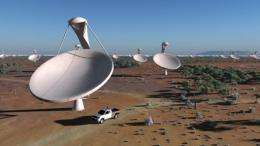Australia hails surprise super-telescope decision

Australia has hailed a surprise decision giving it a role in a radio telescope project aimed at revolutionising astronomy, vowing to draw on its decades of experience in space science.
Australia and South Africa were named joint winners of the Square Kilometre Array (SKA) project following a meeting of the organisation's members in the Netherlands on Friday.
South Africa had been widely expected to win the bid outright and the dual site decision came as a surprise.
Australia was elated at winning a role in the ambitious SKA, which will use a forest of antennae, spread across remote terrain, to pick up radio signals from cosmic phenomena that cannot be detected by optical telescopes.
The SKA will be 50 times more powerful than current radio telescopes and will explore exploding stars, black holes, dark energy and traces of the Universe's origins some 14 billion years ago.
"It is exciting that Australia will play such a prominent role in what is one of the largest international collaborations in science," said the Australian government's chief scientist Ian Chubb.
The government science agency CSIRO said Australia was well qualified to take part in the SKA, with more than 60 years experience in radio astronomy including support of NASA's manned missions to the moon.
"This is a fantastic outcome for Australia, and for international science," said CSIRO chief Megan Clark.
Brian Boyle, director of the Australian bid, which was jointly prepared with and will include telescopes in New Zealand, said the project "will ensure that the expertise brought to the project is truly capitalised on".
Australia's core site is about 100 kilometres (60 miles) west of Meekathara in the deep radio silence of its remote red-sand desert, with antennae distributed as far as New Zealand.
CSIRO said construction of the SKA would start in 2016, with 60 mid-frequency dishes and an array of low-frequency antennae.
Preliminary operations were expected to be under way by 2020.
(c) 2012 AFP




















